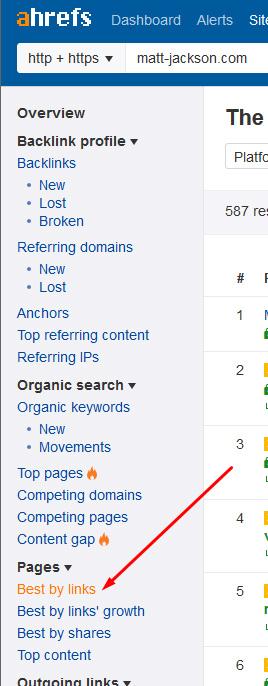Specific Ecommerce Internal Linking Tactics
Here are the different types of internal linking that will benefit the rankings of your ecommerce store.
Finding Pages with Link Equity
The pages with the best inbound links will be able to provide more power to your sub-pages via internal linking.
Therefore we want to list our most powerful pages, and link them to our most important pages (the ones we want to rank).
In ahrefs, this can be done by putting your site into the Site Explorer tool, and selecting "Best by links" in the left column.

Anchor Text for Internal Links
Like inbound links, internal links anchor text should not be overused.
On an ecommerce site you will often already have plenty of exact match internal links from your navigation, breadcrumbs and category lists, so it's important to use long tail variations and synonyms to diversify your internal anchor text.
While there is no specific ratio to follow, simply be descriptive with your anchor text, for example instead of "hd tvs" you could use "shop our best selection of televisions in high definition here".
Where to Add Internal Links on Ecommerce Websites
There are various locations, other than the navigation, footer, sidebars and breadcrumbs, where you can add internal links.
1. Relevant Blog Posts / Informational Pages
There is a good chance that you're regularly producing industry relevant content, and / or have relevant information pages about your products or services on your website.
Within this content you can add internal links, to important and relevant categories and product pages.
2. Category Page Descriptions
A good category page contains lots of relevant text and information about the product type, and can also include some great internal links to top products and other categories.
You may have product comparison pages, lists of best buys, or sale pages, all of which could benefit from the internal links on this page.
3. Product Descriptions
Adding links to the product descriptions isn't always appropriate. Often the user only needs to see related products below this, in case they want a different product after browsing.
However there are some situations where adding links to similar variations of the product, for example different colours and specifications, or perhaps good bundles, could be both relevant and good for rankings.
Avoiding Keyword Cannibalisation
While using a diverse range of anchor text internally is good, you don't want to slip into confusing Google about the topic of the page.
Make sure to only use the specific phrase that describes your category or product, otherwise you can end up with what's known as keyword cannibalisation (more info here).

